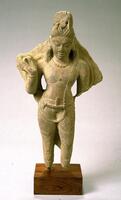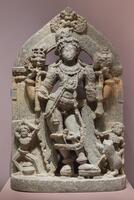7 UMMA Objects
7 UMMA Objects
![Shiva sits with his consort on a double lotus pedestal. He has six arms, his right three are in varada mudra [a giving gesture], holds a rosary and an arrow. His left arms cup his consorts left breast and hold a lotus flower and a bow. He sits in royal ease, with one leg pendant. He wears bracelets, armlets, necklaces, earrings, and a sacred thread that stretches form his left shoulder down past his waist. On his head he wears an elaborate jatamukuta, a crown interlaced with his matted locks. Parvati sits upon his knee with one leg tucked under her and the other pendant. She is also adorned with jewelry, but wears a more modest diadem at the front of her head.<br /> Shiva sits with his consort on a double lotus pedestal. He has six arms, his right three are in varada mudra [a giving gesture], holds a rosary and an arrow. His left arms cup his consorts left breast and hold a lotus flower and a bow. He sits in royal ease, with one leg pendant. He wears bracelets, armlets, necklaces, earrings, and a sacred thread that stretches form his left shoulder down past his waist. On his head he wears an elaborate jatamukuta, a crown interlaced with his matted locks. Parvati sits upon his knee with one leg tucked under her and the other pendant. She is also adorned with jewelry, but wears a more modest diadem at the front of her head.<br />](/media/W1siZiIsIjIwMjIvMDUvMjUvMnF5ZHF1aXpyaV9kZWZhdWx0LmpwZyJdLFsicCIsInRodW1iIiwiMjQweDIwMCJdXQ?sha=5e9565cd110a2b87)
Indian (Indian (South Asian))
Uma-Maheshvara, a seated Shiva and Parvati (Uma)
12th century
Museum purchase for the James Marshall Plumer Memorial Collection
1964/2.85

Indian (Indian (South Asian))
Standing figure of Shiva
900 – 1099
Gift of Mark and Iuliana Phillips
1998/1.181

Indian (Indian (South Asian))
Shiva standing
1400 – 1599
Gift of Dr. and Mrs. Leo S. Figiel, & Dr. and Mrs. Steven J. Figiel
1978/2.116

Indian (Indian (South Asian))
Dvarapala (temple guardian; pair with 1980/2.291)
15th century
Gift of Dr. and Mrs. Leo S. Figiel and Dr. and Mrs. Steven J. Figiel
1980/2.290

Artist Unknown, India, Rajasthan, Sirohi School
Digambara Jain manuscript page: Jina and monk with Lakshmi-Narayana & Ardhanarishvara (fol. No. 42)
18th century
Gift of Dr. and Mrs. Leo S. Figiel and Dr. and Mrs. Steven J. Figiel
1975/2.166

Indian (Indian (South Asian))
Shiva as Bhairava
1100 – 1299
Gift of Professor Walter M. and Nesta R. Spink in honor of Vishakha Desai and Robert Oxnam
2001/2.131
Loading…

